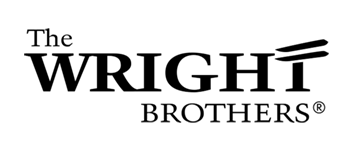Official History & Information

“It was the sport of the thing that appealed to Will and me.”
—Orville Wright
—Orville Wright
Timeline
April 16, 1867
Wilbur Wright born to Reverend Milton Wright and Susan Catherine Koerner Wright near Millville, Indiana. He is their third child; his older siblings are Reuchlin (b. 1861) and Lorin (b. 1862).
Spring, 1869
Wright family moves to Dayton, Ohio..
1871
Bishop Milton Wright sits on the porch of 7 Hawthorn Street, where the family lived from 1871 to 1914.

1871
Bishop Milton Wright sits on the porch of 7 Hawthorn Street, where the family lived from 1871 to 1914.
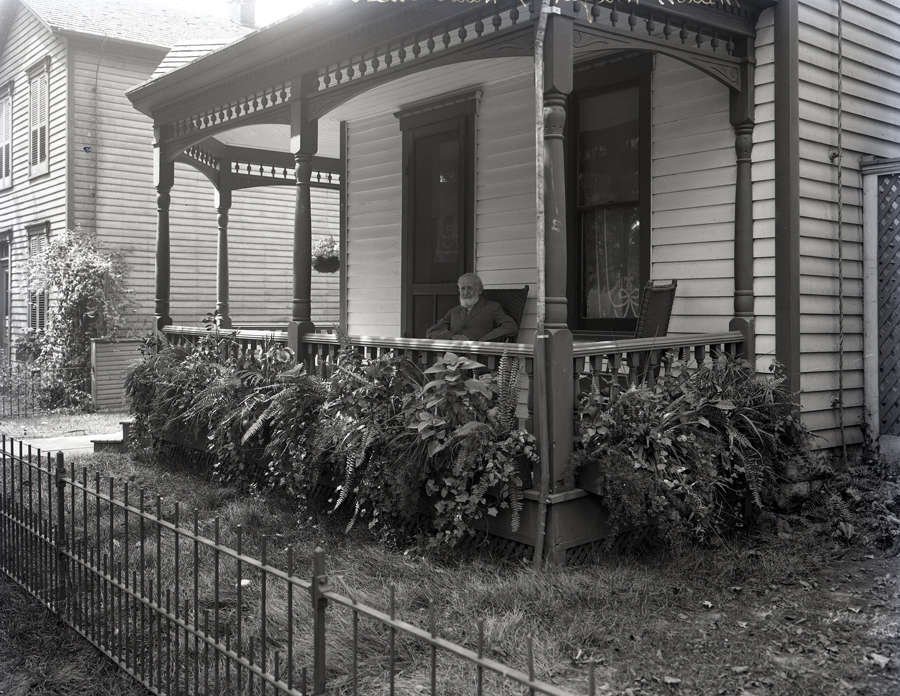
1874
August 19th, Wilbur and Orville’s sister, Katharine Wright, born.
1878
Upon his return from a church business trip, Bishop Milton Wright brings home a toy Penaud helicopter. The toy inspires Wilbur and Orville’s first interest in flight.
1881
Wright family moves to Richmond, Indiana, where Orville takes up kite-building.
1884
June
Wright family returns to Dayton.
1885
Wilbur, Orville and Katharine attended Central High School, located at Fourth and Wilkinson Streets in downtown Dayton. While neither Wilbur nor Orville completed their high school education, Katharine graduated from Central in 1892. Image courtesy of the Dayton Metro Library.

September
Wilbur takes special “postgraduate” courses at Dayton Central High School and studies Greek and trigonometry.
Wilbur takes special “postgraduate” courses at Dayton Central High School and studies Greek and trigonometry.
1886
With his friend Ed Sines, Orville starts The Midget, a school newspaper, with a press given to him by his brothers and type from his father
1887
September
Orville starts Dayton Central High School.
1889
March, 1
Orville begins to publish the weekly West Side News. Editor and publisher, he maintains an active interest in printing and publishing for several years.
July 4th
Wilbur and Orville’s mother, Susan Catherine Koerner Wright, dies at age 58.
July 4th
Wilbur and Orville’s mother, Susan Catherine Koerner Wright, dies at age 58.
1890
April
The April 20, 1890 issue of The West Side News, published by Orville and edited by Wilbur Wright. (img from the collections of Dayton History.)
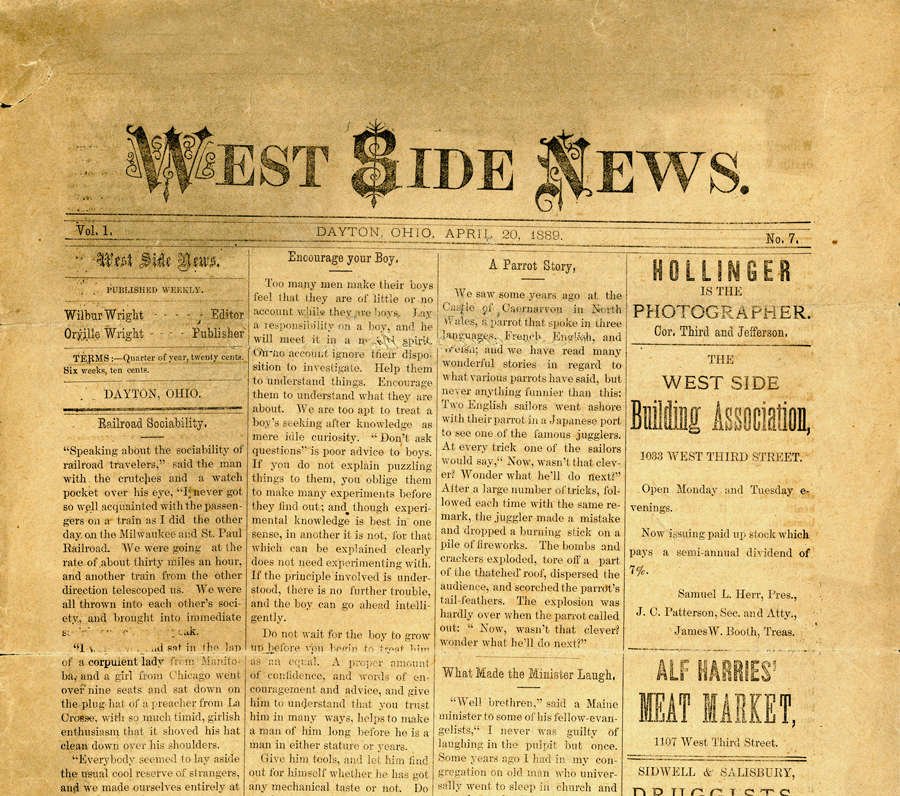
April 30th
Orville and Wilbur turn West Side News into an evening newspaper, The Evening Item, although publication ceases in August.
The Central High School class of 1890, which included both Orville Wright (fourth from left, back row) and Paul Laurence Dunbar (far left, back row). Image from the William Preston Mayfield/Marvin Christian Collection at Dayton History.
The Central High School class of 1890, which included both Orville Wright (fourth from left, back row) and Paul Laurence Dunbar (far left, back row). Image from the William Preston Mayfield/Marvin Christian Collection at Dayton History.

September
Orville begins final year of high school as a special student in Latin. Leaves school before graduation.
December 13th
Paul Laurence Dunbar starts the Dayton Tattler, printed by his classmate, Orville Wright
1892
December
Orville and Wilbur open a bicycle shop, the Wright Cycle Company. They remain in the bicycle manufacturing and repair business until 1907. The business gives them the funds necessary to carry out their early aeronautical experiments.
1893
The world’s first Ferris Wheel was a highlight of the midway at the World’s Columbian Exposition in Chicago, Illinois. More than 47 million people visited the world’s fair between May and October of 1893.
(Image from the NCR Archive at Dayton History.)
Wilbur and Orville attend World’s Columbian Exposition in Chicago where the aeronautical exhibit draws their interest.
(Image from the NCR Archive at Dayton History.)
Wilbur and Orville attend World’s Columbian Exposition in Chicago where the aeronautical exhibit draws their interest.
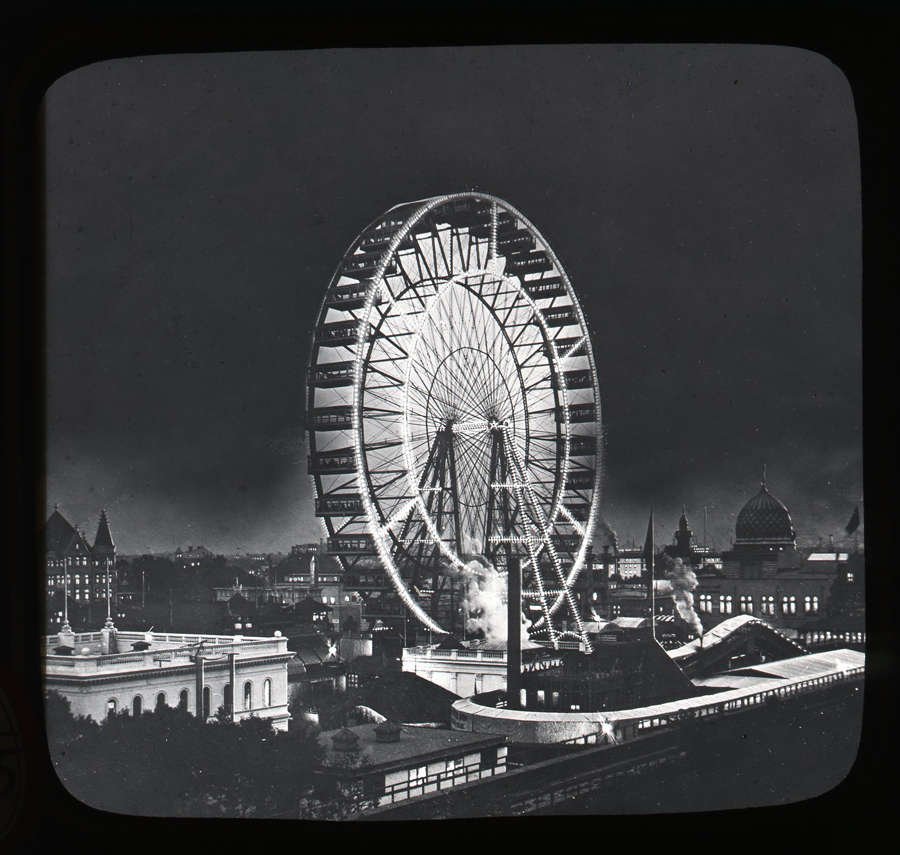
1894
October 20
Wilbur and Orville start a weekly magazine, Snap Shots.
1895
An 1895 advertisement for the Wright Cycle Company shows the different prices that bicycles were being sold for at the time.
Image from the William Preston Mayfield/Marvin Christian Collection at Dayton History.
Image from the William Preston Mayfield/Marvin Christian Collection at Dayton History.
Orville invents a calculating machine that multiplies and adds.
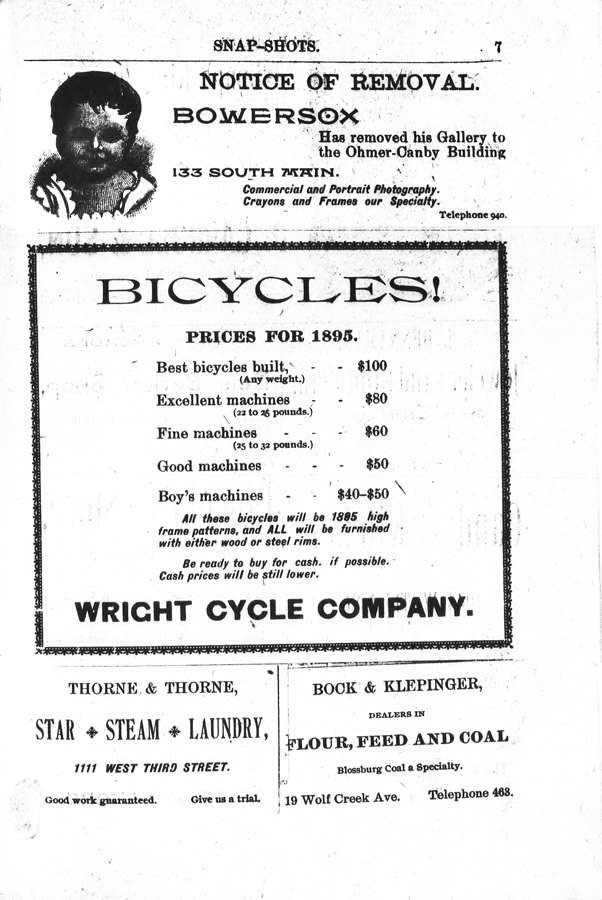
1896
Wright brothers begin to manufacture their own brand of bicycles—first the Van Cleve and the “Wright Special,” and later the less expensive St. Clair.
August–October
Orville seriously ill with typhoid fever.
August–October
Orville seriously ill with typhoid fever.
August 10
Otto Lilienthal, German engineer and aeronautical pioneer, dies from injuries suffered in a crash while testing his latest single-surface glider. The tragedy renews the Wright brothers’ interest in Lilienthal and the problem of human flight.
1897–1898
While running their bicycle business, Wilbur and Orville study the problems of mechanical and human flight. After reading extensively and studying bird flight and Lilienthal’s work, the brothers are convinced that human flight is possible and decide to conduct some experiments of their own.
1899
May 30
Wilbur writes Smithsonian Institution inquiring about publications on aeronautical subjects.
July–August
July–August
Brothers build and Wilbur flies a biplane kite in order to test the “wing-warping” method of controlling a flying machine. This experiment encourages the Wrights to proceed with constructing a flying machine with a pilot.
November 27
Brothers write the U.S. Weather Bureau for information on an appropriate place to conduct flying experiments.
1900
May 13
Wilbur writes to Octave Chanute, a civil engineer and aeronautical pioneer. Correspondence begins an important friendship lasting until Chanute’s death in 1910.
September 6
September 6
Wilbur leaves for Kitty Hawk, North Carolina. Orville arrives later and they stay with William J. Tate until their camp is ready in early October.
October
October
Wrights begin their experiments, flying their glider as a kite and as a man-carrying glider. About a dozen free flights are made although total time in the air is only about two minutes. They stay until October 23.
1901
June 26
Octave Chanute meets the Wrights for the first time in Dayton.
July
July
Wilbur’s articles, “Angle of Incidence,” published in Aeronautical Journal, and “Die Wagerechte Lage Wahrend des Gleitfluges,” published in Ilustrierte Aeronautische Mitteilungen, are the brothers’ first published aeronautical writings.
July 10
Wrights arrive in Kitty Hawk and begin experiments with a larger glider. From fifty to one hundred flights are made in July and August, ranging in distance from twenty to almost four hundred feet.
August 4–11
August 4–11
Chanute visits the Wrights at Kill Devil Hill and witnesses some of their glider experiments.
August 20
August 20
Wrights leave Kitty Hawk.
September 18
September 18
Wilbur addresses the Western Society of Engineers on the brothers’ 1900–01 gliding experiments.
October–December
October–December
Wrights conduct tests on airfoils and build a wind tunnel.
1902
August 28
Octave Chanute meets the Wrights for the first time in Dayton.
August 28
Wilbur and Orville arrive at their Kitty Hawk camp.
September 8–19
Wrights assemble their new glider.
August 28
Wilbur and Orville arrive at their Kitty Hawk camp.
September 8–19
Wrights assemble their new glider.
September 19–October 24
Wright brothers make between seven hundred and one thousand glides and increase their distance to 622-1/2 feet.
October 28
Wrights leave Kitty Hawk.
December
Wrights conduct experiments with propellers and begin to build their 1903 four-cylinder engine.
1903
Orville Wright’s classmate, Paul Laurence Dunbar, giving a speech in the women’s dining room at the National Cash Register Company on January 6, 1903.
Image from the NCR Archive at Dayton History.
March 23
Image from the NCR Archive at Dayton History.
March 23
Wright brothers apply for a patent on their flying machine (patent issued May 22, 1906).
September 25
September 25
Wilbur and Orville arrive at Kitty Hawk.
September 28–November 12
Wrights experiment with 1902 glider.
October 9–November 4
October 9–November 4
Brothers assemble the 1903 machine and install the engine.
November 5–December 9
November 5–December 9
Propeller shafts break twice and brothers return to Dayton to repair them and obtain replacements.
December 14
Wilbur makes the first, but unsuccessful, attempt to fly a powered machine from slope of Big Kill Devil Hill. Machine stalls after 3-1/2 seconds in the air and lands 105 feet below.
December 17
December 17
Wilbur and Orville make the first free, controlled, and sustained flights in a power-driven, heavier-than-air machine. Three men from the Kill Devil Life Saving Station and two from Nags Head witness the four trial flights. First trial is made by Orville at 10:35 A.M., stays twelve seconds in the air, and flies 120 feet. John T. Daniels photographs the first flight with Orville’s camera. Wilbur makes the longest flight in the fourth trial, fifty-nine seconds in the air and 852 feet.
December 21
December 21
Wrights leave Kitty Hawk.
1904
Orville Wright’s classmate, Paul Laurence Dunbar, giving a speech in the women’s dining room at the National Cash Register Company on January 6, 1903.
Image from the NCR Archive at Dayton History.
March 23
Image from the NCR Archive at Dayton History.
March 23
Wright brothers apply for a patent on their flying machine (patent issued May 22, 1906).
September 25
September 25
Wilbur and Orville arrive at Kitty Hawk.
September 28–November 12
Wrights experiment with 1902 glider.
October 9–November 4
October 9–November 4
Brothers assemble the 1903 machine and install the engine.
November 5–December 9
November 5–December 9
Propeller shafts break twice and brothers return to Dayton to repair them and obtain replacements.
December 14
Wilbur makes the first, but unsuccessful, attempt to fly a powered machine from slope of Big Kill Devil Hill. Machine stalls after 3-1/2 seconds in the air and lands 105 feet below.
December 17
December 17
Wilbur and Orville make the first free, controlled, and sustained flights in a power-driven, heavier-than-air machine. Three men from the Kill Devil Life Saving Station and two from Nags Head witness the four trial flights. First trial is made by Orville at 10:35 A.M., stays twelve seconds in the air, and flies 120 feet. John T. Daniels photographs the first flight with Orville’s camera. Wilbur makes the longest flight in the fourth trial, fifty-nine seconds in the air and 852 feet.
December 21
December 21
Wrights leave Kitty Hawk.
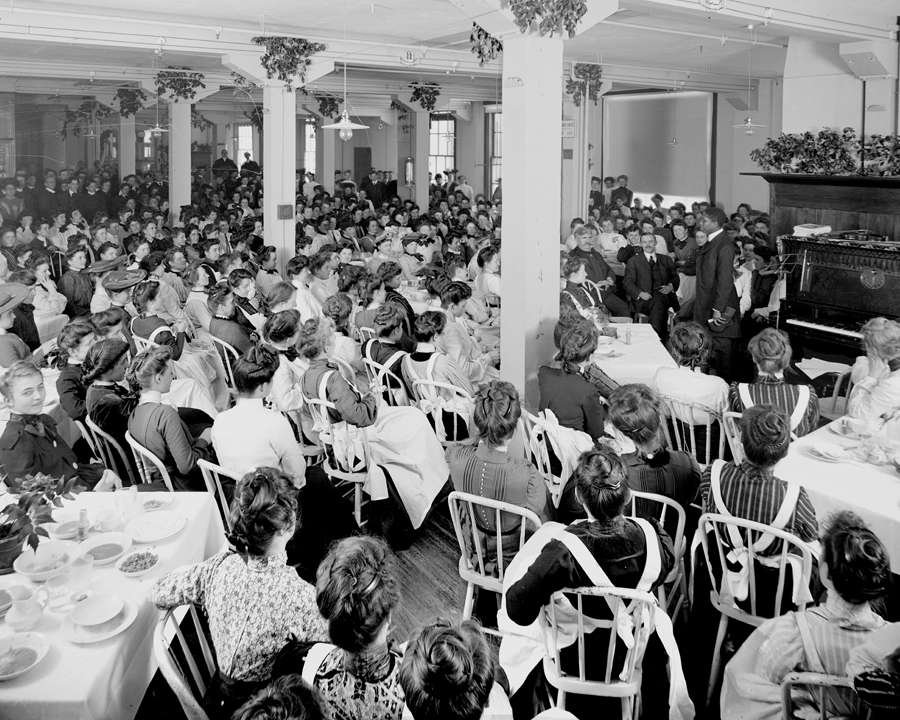
1901
June 26
Octave Chanute meets the Wrights for the first time in Dayton.
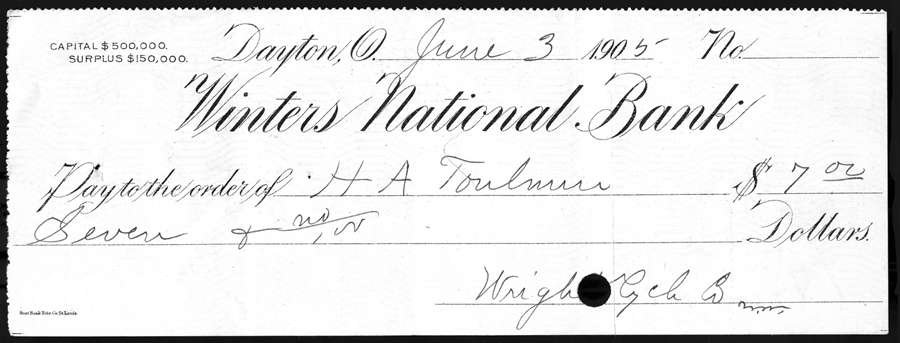
1901
June 26
Octave Chanute meets the Wrights for the first time in Dayton.

